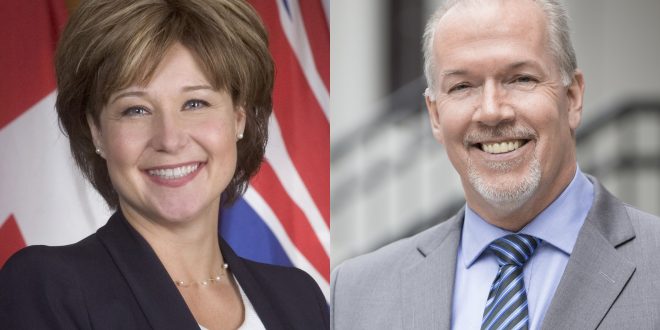AGE, gender and regional differences have pushed the two main contending parties in the British Columbia provincial election into a tie, as the BC Green Party is poised to have its best showing ever, a new Insights West poll conducted for CTV Vancouver has found.
The online survey of a representative sample of British Columbians shows that the approval rating for all three leaders improved as the campaign progressed. Andrew Weaver of the BC Green Party heads to election with the highest numbers (46%, +11 since the first Insights West survey conducted in April). Opposition and BC New Democratic Party (NDP) leader John Horgan stands at 42% (+5), while Premier and BC Liberals leader Christy Clark is at 38% (+8).
Weaver is the only leader with a positive momentum score of +13 (28% say their opinion of the BC Green leader improved since the start of the campaign, while 15% say it has worsened). Horgan is at -15 (with 34% saying they now have a worse opinion of him) and Clark at -29 (with 36% saying they now have worse opinion of her).
When asked who would make the best Premier of British Columbia, Clark is in first place with 33% (+8), followed by Horgan at 28% (+6) and Weaver at 17% (+5). The level of undecided respondents on this question has dropped from 41% in April to 21% this month.
Horgan is still seen as the best person to deal with health care (40%), education (39%), housing, poverty and homelessness (37%) and accountability (26%). Clark leads on handling the economy and jobs (47%, +9), energy and pipelines (41%) and crime and public safety (33%), while Weaver is regarded as the best leader on environmental issues (49%).

Large proportions of British Columbians say Premier Clark shares their views on creating jobs (43%), managing the province’s finances (41%) and transportation projects (33%), while Horgan is first on the issues of child care (34%) and seniors care (32%).
Horgan began the campaign as the leader who connected best on two other issues, but now trails Clark on helping residents become homeowners (Clark 28%, Horgan 24%, Weaver 11%) and Weaver on fundraising for political parties (Weaver 22%, Clark 20%, Horgan 19%).
“Our mid-campaign poll showed that residents aged 55 and over are decidedly in favor of the governing party on financial matters,” says Mario Canseco, Vice President, Public Affairs, at Insights West. “The campaign has helped solidify the position of the BC Liberals as economic managers, as evidenced by the double-digit improvement for Premier Clark on some of these questions.”
The most important issue facing the province continues to be housing, poverty and homelessness (35%, -3), but now the economy and jobs has climbed to second place (24%, +8) followed by health care (19%, =).
Among decided voters, the two main parties are backed by about two-in-five decided voters, with 41% (+1) saying they would or have cast a ballot for the BC NDP candidate in their riding, and 41% (+3) saying they supported or will support the BC Liberals. The Green Party is third with 17%, while 2% would vote for other parties or independent candidates.
Men (47%), voters aged 55 and over (49%) and those in the Okanagan and the North (52%) are more likely to cast a ballot for the BC Liberals, while women (43%), those aged 18-to-34 (46%) and those aged 35-to-54 (also 46%) are more likely to back the BC NDP.
The two main parties are keeping about four-in-five of their voters from the 2013 provincial election (79% for the BC Liberals, 80% for the BC NDP).
Only 13% of decided voters say they may change their mind before tomorrow’s election. While at the start of the campaign, only 52% of BC Green Party voters were committed to their choice, the proportion has increased to 77%, greatly improving the party’s chances of having its best showing ever in a provincial election.
Among British Columbians who voted for the Liberal Party in the 2015 Canadian federal election, the BC Liberals continue to lead (51%) with the BC NDP a distant second (32%). Three-in-four federal Conservatives (76%) intend to vote for the BC Liberals, while four-in-five federal NDP supporters (81%) will vote for the BC NDP.
BC Liberal voters say they are motivated primarily by the party’s ideas and policies (38%), a desire for stability (29%) and the party’s candidate in their riding (13%). Supporters of the two main opposition parties place their emphasis on ideas and policies (36% among NDP voters, 39% among Green voters), desire for change (33% among NDP voters, 25% among Green voters) and disgust with other contending candidates (14% among NDP voters, 23% among Green voters).
It is important to note that only 5% of decided voters say their main motivator for their vote is the party leader. In the last federal election, this indicator stood at 14%, and climbed to 18% among the British Columbians who voted for the Justin Trudeau-led Liberal Party.
Regardless of the election’s outcome, the province is staunchly divided. Across British Columbia, 49% of residents say they would be “very upset” if the BC Liberals form the government again, while 46% claim they would be “very upset” if the BC NDP wins the election.
The sentiment for a change of government in the province has dropped slightly, from 64% in April to 61% this month. This measurement differs from what Insights West observed before issuing accurate forecasts in two recent provincial elections where incumbent governments were defeated: Alberta 2015 (82%) and Manitoba 2016 (67%).
 Desi Today Magazine
Desi Today Magazine




